Strategic Management in Agribusiness: Australian Grain Industry Report
VerifiedAdded on 2022/10/31
|10
|2805
|222
Report
AI Summary
This report provides a strategic analysis of the agribusiness sector, specifically focusing on the Australian grain industry. It begins with an introduction to strategic management and its importance in evaluating internal and external forces within the industry. The report identifies key environmental issues, including economic, technological, and environmental factors affecting the grain industry. It then delves into the industry structure, competitive positioning of major players like GrainCorp, Manildra Group, and SunRice, and the industry's attractiveness. A significant portion of the report analyzes the implications of the robotics trend in agriculture, discussing its impact on industry attractiveness and the potential benefits for farmers. The report concludes with recommendations for integrating robotics and automation technologies to improve efficiency, reduce labor requirements, and enhance profitability. Overall, the report offers a comprehensive overview of the strategic considerations within the agribusiness sector and the transformative potential of technological advancements.
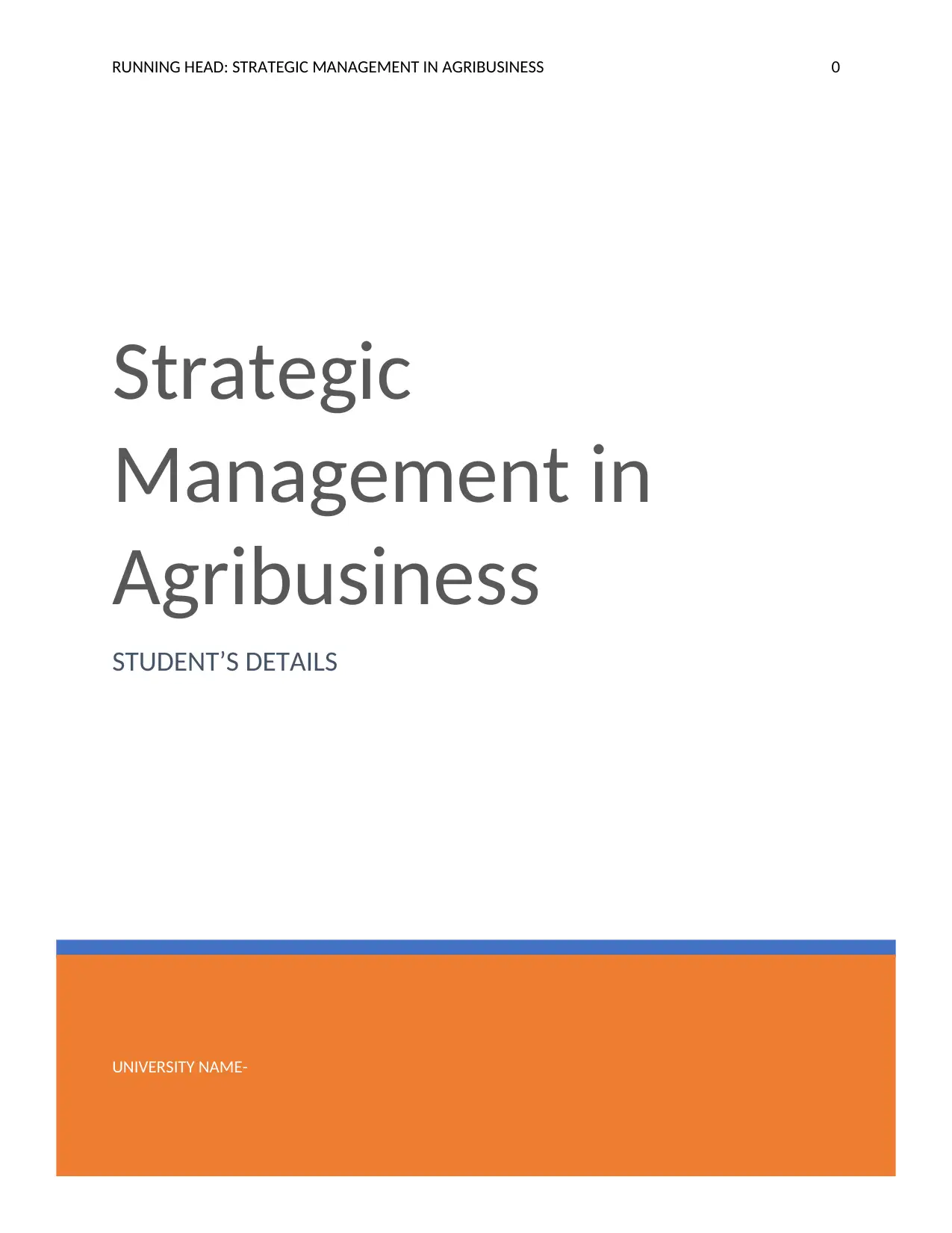
UNIVERSITY NAME-
Strategic
Management in
Agribusiness
STUDENT’S DETAILS
RUNNING HEAD: STRATEGIC MANAGEMENT IN AGRIBUSINESS 0
Strategic
Management in
Agribusiness
STUDENT’S DETAILS
RUNNING HEAD: STRATEGIC MANAGEMENT IN AGRIBUSINESS 0
Paraphrase This Document
Need a fresh take? Get an instant paraphrase of this document with our AI Paraphraser
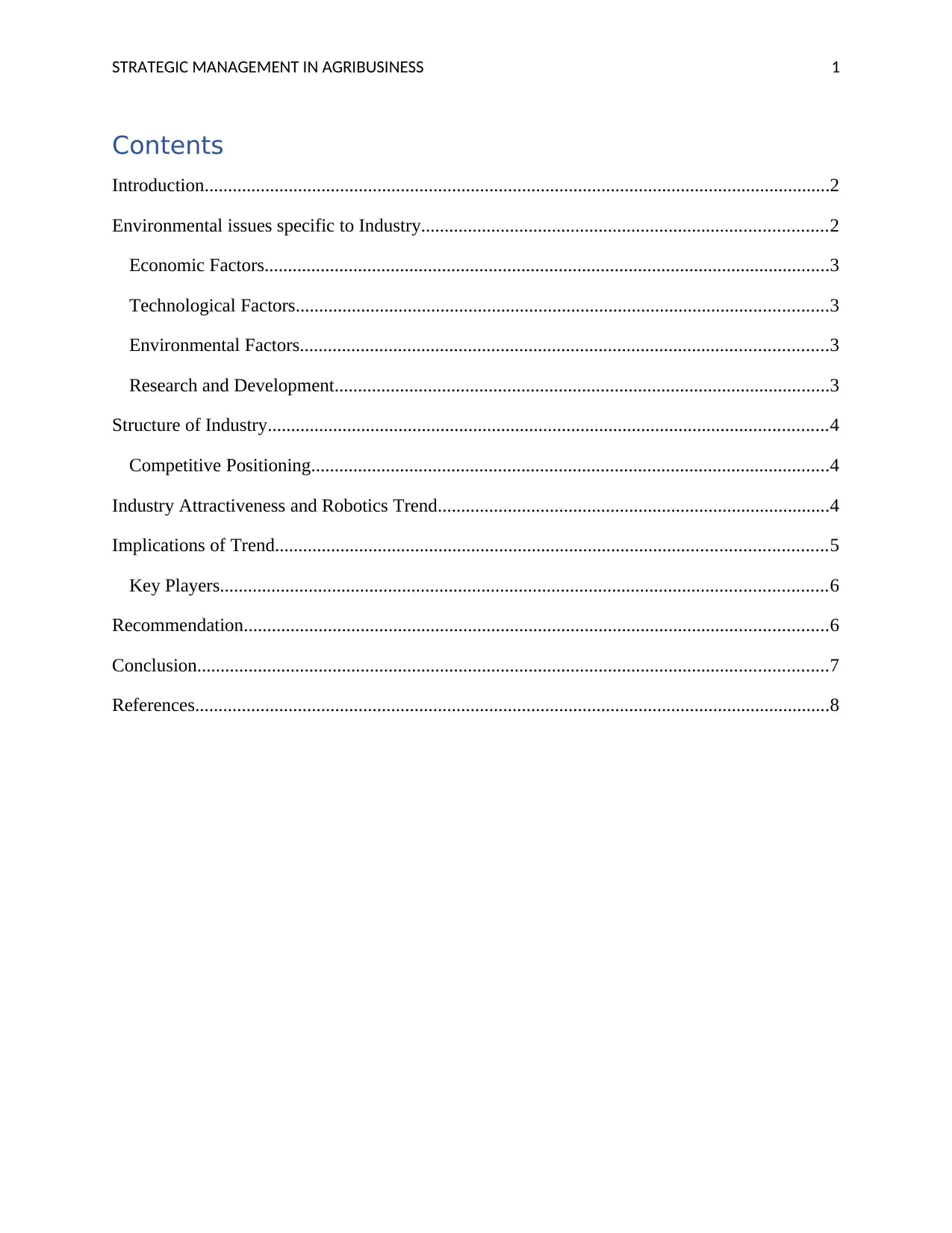
STRATEGIC MANAGEMENT IN AGRIBUSINESS 1
Contents
Introduction......................................................................................................................................2
Environmental issues specific to Industry.......................................................................................2
Economic Factors.........................................................................................................................3
Technological Factors..................................................................................................................3
Environmental Factors.................................................................................................................3
Research and Development..........................................................................................................3
Structure of Industry........................................................................................................................4
Competitive Positioning...............................................................................................................4
Industry Attractiveness and Robotics Trend....................................................................................4
Implications of Trend......................................................................................................................5
Key Players..................................................................................................................................6
Recommendation.............................................................................................................................6
Conclusion.......................................................................................................................................7
References........................................................................................................................................8
Contents
Introduction......................................................................................................................................2
Environmental issues specific to Industry.......................................................................................2
Economic Factors.........................................................................................................................3
Technological Factors..................................................................................................................3
Environmental Factors.................................................................................................................3
Research and Development..........................................................................................................3
Structure of Industry........................................................................................................................4
Competitive Positioning...............................................................................................................4
Industry Attractiveness and Robotics Trend....................................................................................4
Implications of Trend......................................................................................................................5
Key Players..................................................................................................................................6
Recommendation.............................................................................................................................6
Conclusion.......................................................................................................................................7
References........................................................................................................................................8
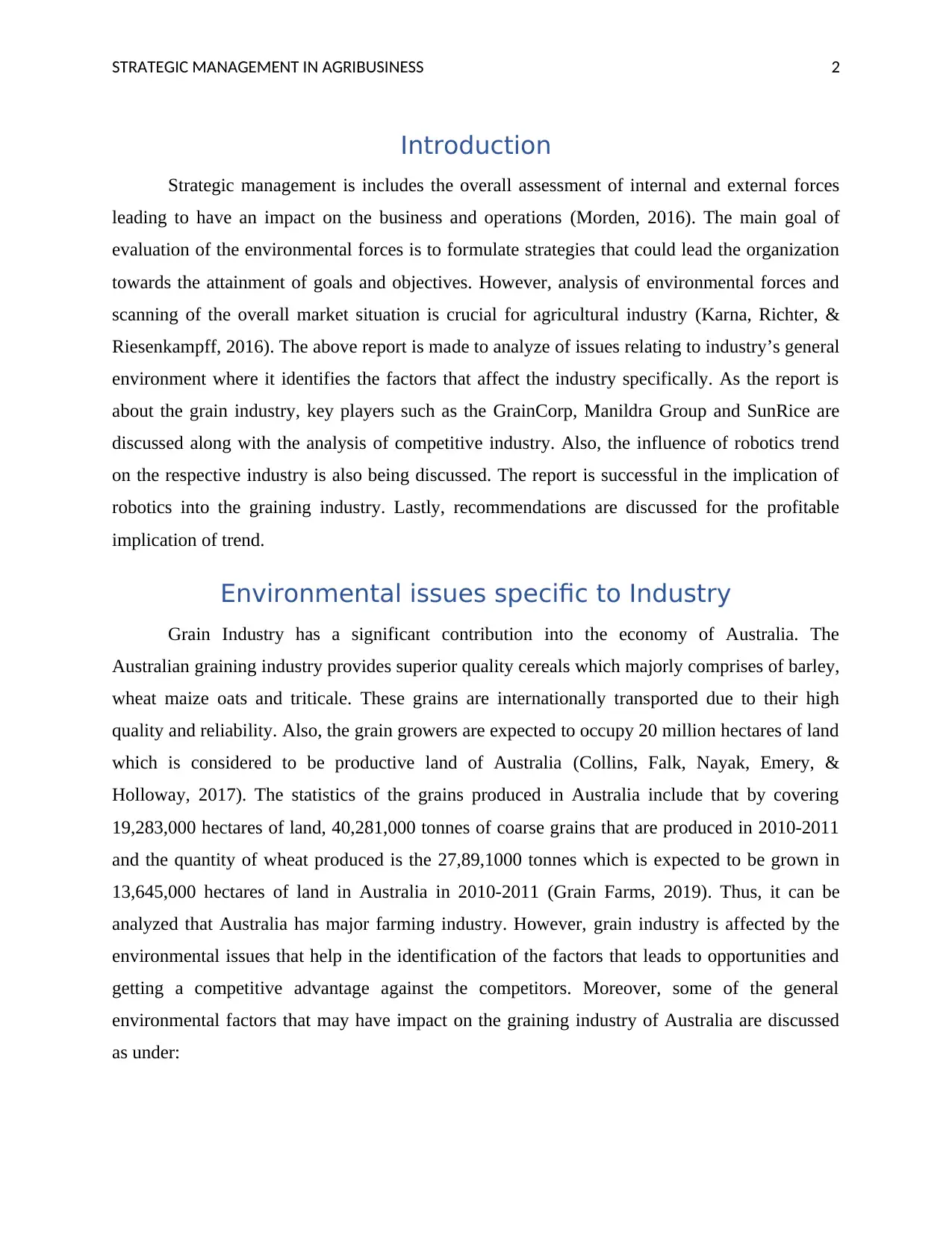
STRATEGIC MANAGEMENT IN AGRIBUSINESS 2
Introduction
Strategic management is includes the overall assessment of internal and external forces
leading to have an impact on the business and operations (Morden, 2016). The main goal of
evaluation of the environmental forces is to formulate strategies that could lead the organization
towards the attainment of goals and objectives. However, analysis of environmental forces and
scanning of the overall market situation is crucial for agricultural industry (Karna, Richter, &
Riesenkampff, 2016). The above report is made to analyze of issues relating to industry’s general
environment where it identifies the factors that affect the industry specifically. As the report is
about the grain industry, key players such as the GrainCorp, Manildra Group and SunRice are
discussed along with the analysis of competitive industry. Also, the influence of robotics trend
on the respective industry is also being discussed. The report is successful in the implication of
robotics into the graining industry. Lastly, recommendations are discussed for the profitable
implication of trend.
Environmental issues specific to Industry
Grain Industry has a significant contribution into the economy of Australia. The
Australian graining industry provides superior quality cereals which majorly comprises of barley,
wheat maize oats and triticale. These grains are internationally transported due to their high
quality and reliability. Also, the grain growers are expected to occupy 20 million hectares of land
which is considered to be productive land of Australia (Collins, Falk, Nayak, Emery, &
Holloway, 2017). The statistics of the grains produced in Australia include that by covering
19,283,000 hectares of land, 40,281,000 tonnes of coarse grains that are produced in 2010-2011
and the quantity of wheat produced is the 27,89,1000 tonnes which is expected to be grown in
13,645,000 hectares of land in Australia in 2010-2011 (Grain Farms, 2019). Thus, it can be
analyzed that Australia has major farming industry. However, grain industry is affected by the
environmental issues that help in the identification of the factors that leads to opportunities and
getting a competitive advantage against the competitors. Moreover, some of the general
environmental factors that may have impact on the graining industry of Australia are discussed
as under:
Introduction
Strategic management is includes the overall assessment of internal and external forces
leading to have an impact on the business and operations (Morden, 2016). The main goal of
evaluation of the environmental forces is to formulate strategies that could lead the organization
towards the attainment of goals and objectives. However, analysis of environmental forces and
scanning of the overall market situation is crucial for agricultural industry (Karna, Richter, &
Riesenkampff, 2016). The above report is made to analyze of issues relating to industry’s general
environment where it identifies the factors that affect the industry specifically. As the report is
about the grain industry, key players such as the GrainCorp, Manildra Group and SunRice are
discussed along with the analysis of competitive industry. Also, the influence of robotics trend
on the respective industry is also being discussed. The report is successful in the implication of
robotics into the graining industry. Lastly, recommendations are discussed for the profitable
implication of trend.
Environmental issues specific to Industry
Grain Industry has a significant contribution into the economy of Australia. The
Australian graining industry provides superior quality cereals which majorly comprises of barley,
wheat maize oats and triticale. These grains are internationally transported due to their high
quality and reliability. Also, the grain growers are expected to occupy 20 million hectares of land
which is considered to be productive land of Australia (Collins, Falk, Nayak, Emery, &
Holloway, 2017). The statistics of the grains produced in Australia include that by covering
19,283,000 hectares of land, 40,281,000 tonnes of coarse grains that are produced in 2010-2011
and the quantity of wheat produced is the 27,89,1000 tonnes which is expected to be grown in
13,645,000 hectares of land in Australia in 2010-2011 (Grain Farms, 2019). Thus, it can be
analyzed that Australia has major farming industry. However, grain industry is affected by the
environmental issues that help in the identification of the factors that leads to opportunities and
getting a competitive advantage against the competitors. Moreover, some of the general
environmental factors that may have impact on the graining industry of Australia are discussed
as under:
⊘ This is a preview!⊘
Do you want full access?
Subscribe today to unlock all pages.

Trusted by 1+ million students worldwide
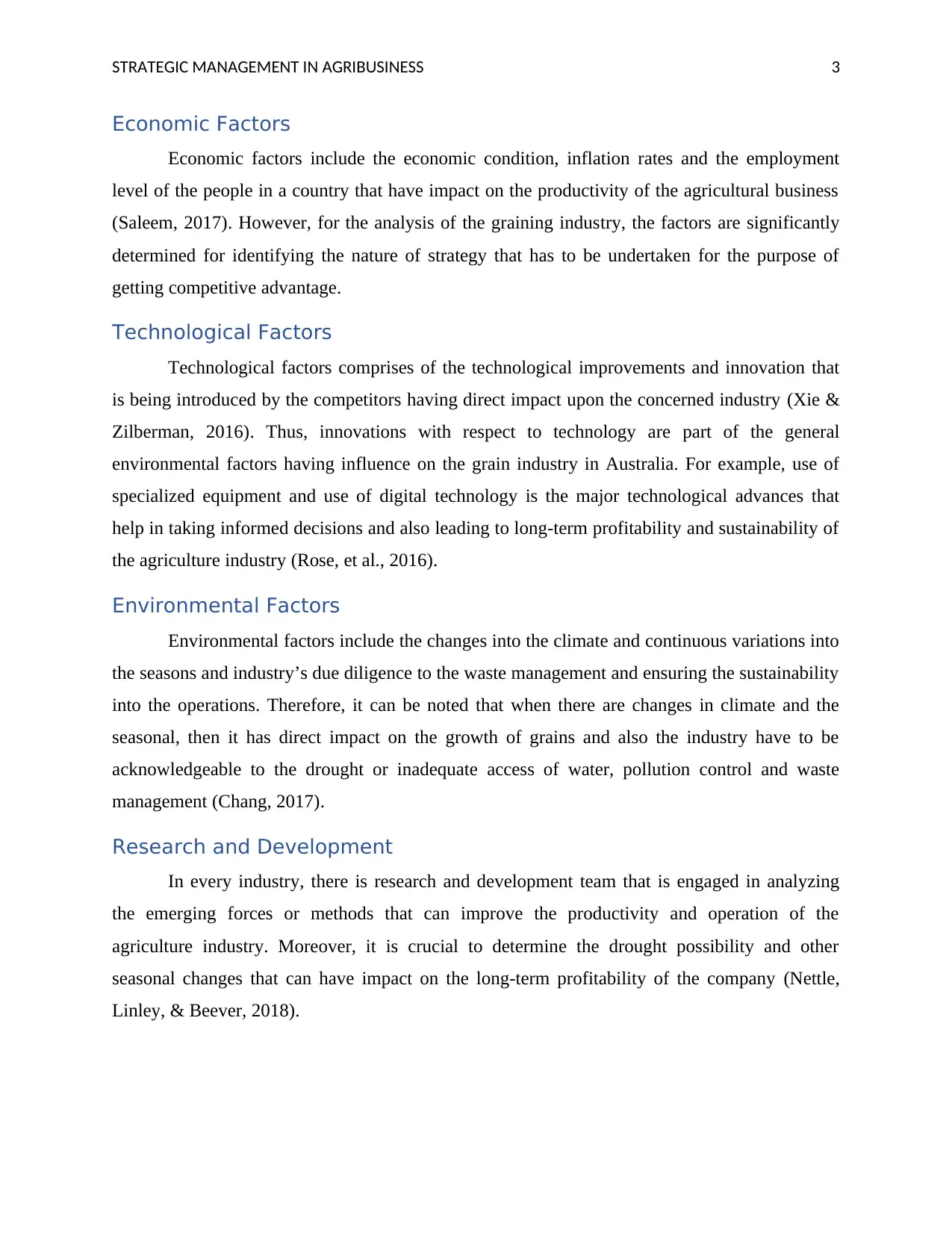
STRATEGIC MANAGEMENT IN AGRIBUSINESS 3
Economic Factors
Economic factors include the economic condition, inflation rates and the employment
level of the people in a country that have impact on the productivity of the agricultural business
(Saleem, 2017). However, for the analysis of the graining industry, the factors are significantly
determined for identifying the nature of strategy that has to be undertaken for the purpose of
getting competitive advantage.
Technological Factors
Technological factors comprises of the technological improvements and innovation that
is being introduced by the competitors having direct impact upon the concerned industry (Xie &
Zilberman, 2016). Thus, innovations with respect to technology are part of the general
environmental factors having influence on the grain industry in Australia. For example, use of
specialized equipment and use of digital technology is the major technological advances that
help in taking informed decisions and also leading to long-term profitability and sustainability of
the agriculture industry (Rose, et al., 2016).
Environmental Factors
Environmental factors include the changes into the climate and continuous variations into
the seasons and industry’s due diligence to the waste management and ensuring the sustainability
into the operations. Therefore, it can be noted that when there are changes in climate and the
seasonal, then it has direct impact on the growth of grains and also the industry have to be
acknowledgeable to the drought or inadequate access of water, pollution control and waste
management (Chang, 2017).
Research and Development
In every industry, there is research and development team that is engaged in analyzing
the emerging forces or methods that can improve the productivity and operation of the
agriculture industry. Moreover, it is crucial to determine the drought possibility and other
seasonal changes that can have impact on the long-term profitability of the company (Nettle,
Linley, & Beever, 2018).
Economic Factors
Economic factors include the economic condition, inflation rates and the employment
level of the people in a country that have impact on the productivity of the agricultural business
(Saleem, 2017). However, for the analysis of the graining industry, the factors are significantly
determined for identifying the nature of strategy that has to be undertaken for the purpose of
getting competitive advantage.
Technological Factors
Technological factors comprises of the technological improvements and innovation that
is being introduced by the competitors having direct impact upon the concerned industry (Xie &
Zilberman, 2016). Thus, innovations with respect to technology are part of the general
environmental factors having influence on the grain industry in Australia. For example, use of
specialized equipment and use of digital technology is the major technological advances that
help in taking informed decisions and also leading to long-term profitability and sustainability of
the agriculture industry (Rose, et al., 2016).
Environmental Factors
Environmental factors include the changes into the climate and continuous variations into
the seasons and industry’s due diligence to the waste management and ensuring the sustainability
into the operations. Therefore, it can be noted that when there are changes in climate and the
seasonal, then it has direct impact on the growth of grains and also the industry have to be
acknowledgeable to the drought or inadequate access of water, pollution control and waste
management (Chang, 2017).
Research and Development
In every industry, there is research and development team that is engaged in analyzing
the emerging forces or methods that can improve the productivity and operation of the
agriculture industry. Moreover, it is crucial to determine the drought possibility and other
seasonal changes that can have impact on the long-term profitability of the company (Nettle,
Linley, & Beever, 2018).
Paraphrase This Document
Need a fresh take? Get an instant paraphrase of this document with our AI Paraphraser
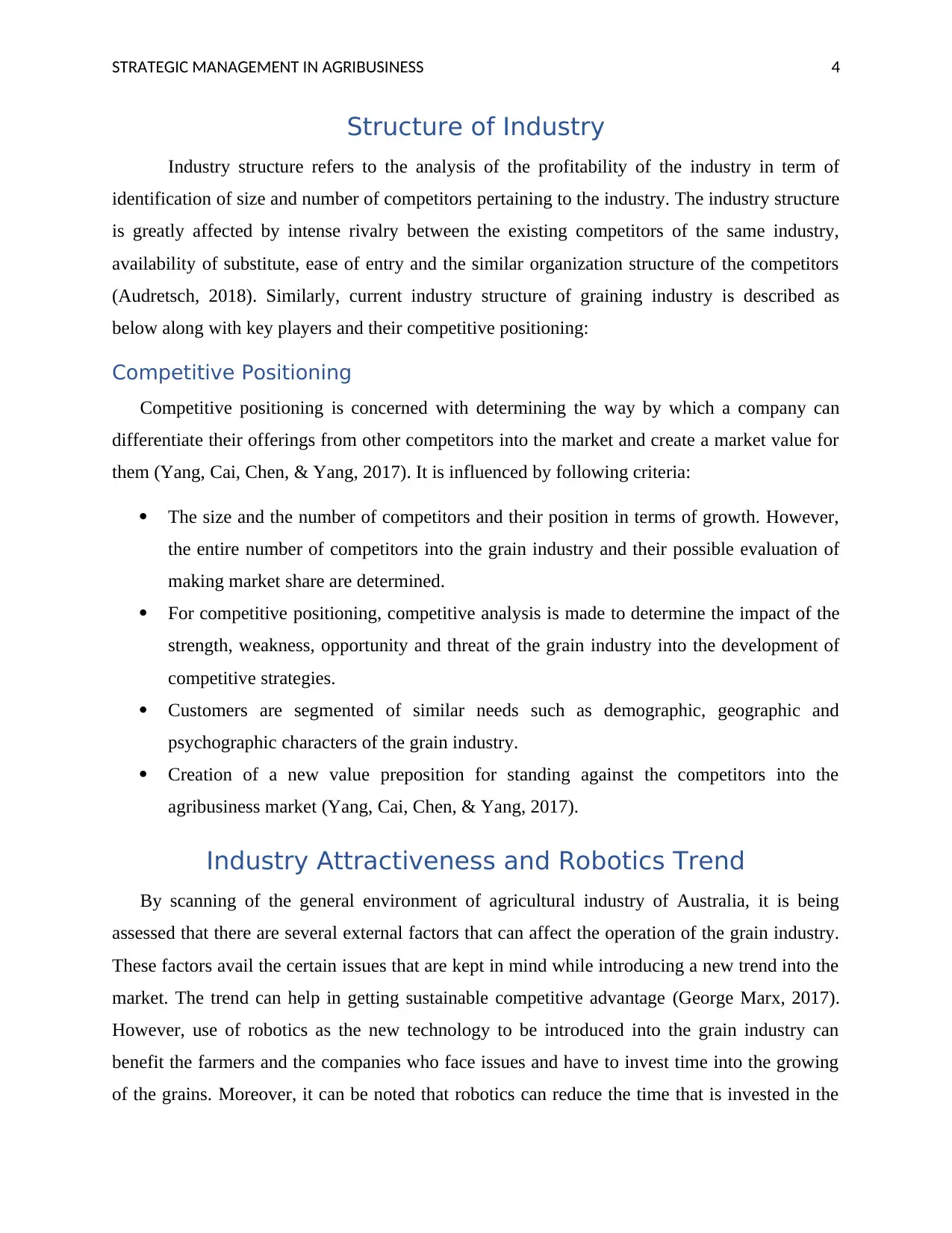
STRATEGIC MANAGEMENT IN AGRIBUSINESS 4
Structure of Industry
Industry structure refers to the analysis of the profitability of the industry in term of
identification of size and number of competitors pertaining to the industry. The industry structure
is greatly affected by intense rivalry between the existing competitors of the same industry,
availability of substitute, ease of entry and the similar organization structure of the competitors
(Audretsch, 2018). Similarly, current industry structure of graining industry is described as
below along with key players and their competitive positioning:
Competitive Positioning
Competitive positioning is concerned with determining the way by which a company can
differentiate their offerings from other competitors into the market and create a market value for
them (Yang, Cai, Chen, & Yang, 2017). It is influenced by following criteria:
The size and the number of competitors and their position in terms of growth. However,
the entire number of competitors into the grain industry and their possible evaluation of
making market share are determined.
For competitive positioning, competitive analysis is made to determine the impact of the
strength, weakness, opportunity and threat of the grain industry into the development of
competitive strategies.
Customers are segmented of similar needs such as demographic, geographic and
psychographic characters of the grain industry.
Creation of a new value preposition for standing against the competitors into the
agribusiness market (Yang, Cai, Chen, & Yang, 2017).
Industry Attractiveness and Robotics Trend
By scanning of the general environment of agricultural industry of Australia, it is being
assessed that there are several external factors that can affect the operation of the grain industry.
These factors avail the certain issues that are kept in mind while introducing a new trend into the
market. The trend can help in getting sustainable competitive advantage (George Marx, 2017).
However, use of robotics as the new technology to be introduced into the grain industry can
benefit the farmers and the companies who face issues and have to invest time into the growing
of the grains. Moreover, it can be noted that robotics can reduce the time that is invested in the
Structure of Industry
Industry structure refers to the analysis of the profitability of the industry in term of
identification of size and number of competitors pertaining to the industry. The industry structure
is greatly affected by intense rivalry between the existing competitors of the same industry,
availability of substitute, ease of entry and the similar organization structure of the competitors
(Audretsch, 2018). Similarly, current industry structure of graining industry is described as
below along with key players and their competitive positioning:
Competitive Positioning
Competitive positioning is concerned with determining the way by which a company can
differentiate their offerings from other competitors into the market and create a market value for
them (Yang, Cai, Chen, & Yang, 2017). It is influenced by following criteria:
The size and the number of competitors and their position in terms of growth. However,
the entire number of competitors into the grain industry and their possible evaluation of
making market share are determined.
For competitive positioning, competitive analysis is made to determine the impact of the
strength, weakness, opportunity and threat of the grain industry into the development of
competitive strategies.
Customers are segmented of similar needs such as demographic, geographic and
psychographic characters of the grain industry.
Creation of a new value preposition for standing against the competitors into the
agribusiness market (Yang, Cai, Chen, & Yang, 2017).
Industry Attractiveness and Robotics Trend
By scanning of the general environment of agricultural industry of Australia, it is being
assessed that there are several external factors that can affect the operation of the grain industry.
These factors avail the certain issues that are kept in mind while introducing a new trend into the
market. The trend can help in getting sustainable competitive advantage (George Marx, 2017).
However, use of robotics as the new technology to be introduced into the grain industry can
benefit the farmers and the companies who face issues and have to invest time into the growing
of the grains. Moreover, it can be noted that robotics can reduce the time that is invested in the
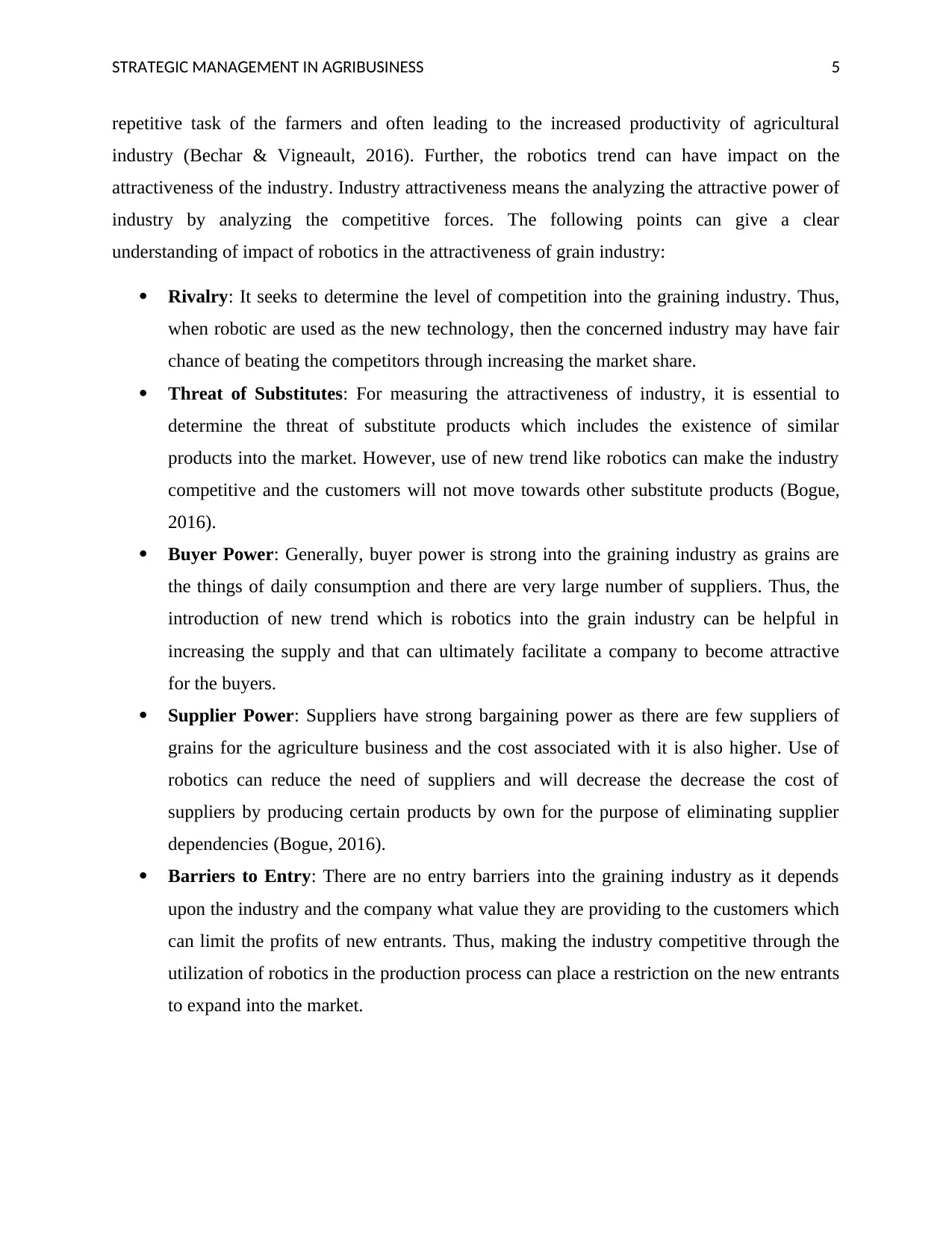
STRATEGIC MANAGEMENT IN AGRIBUSINESS 5
repetitive task of the farmers and often leading to the increased productivity of agricultural
industry (Bechar & Vigneault, 2016). Further, the robotics trend can have impact on the
attractiveness of the industry. Industry attractiveness means the analyzing the attractive power of
industry by analyzing the competitive forces. The following points can give a clear
understanding of impact of robotics in the attractiveness of grain industry:
Rivalry: It seeks to determine the level of competition into the graining industry. Thus,
when robotic are used as the new technology, then the concerned industry may have fair
chance of beating the competitors through increasing the market share.
Threat of Substitutes: For measuring the attractiveness of industry, it is essential to
determine the threat of substitute products which includes the existence of similar
products into the market. However, use of new trend like robotics can make the industry
competitive and the customers will not move towards other substitute products (Bogue,
2016).
Buyer Power: Generally, buyer power is strong into the graining industry as grains are
the things of daily consumption and there are very large number of suppliers. Thus, the
introduction of new trend which is robotics into the grain industry can be helpful in
increasing the supply and that can ultimately facilitate a company to become attractive
for the buyers.
Supplier Power: Suppliers have strong bargaining power as there are few suppliers of
grains for the agriculture business and the cost associated with it is also higher. Use of
robotics can reduce the need of suppliers and will decrease the decrease the cost of
suppliers by producing certain products by own for the purpose of eliminating supplier
dependencies (Bogue, 2016).
Barriers to Entry: There are no entry barriers into the graining industry as it depends
upon the industry and the company what value they are providing to the customers which
can limit the profits of new entrants. Thus, making the industry competitive through the
utilization of robotics in the production process can place a restriction on the new entrants
to expand into the market.
repetitive task of the farmers and often leading to the increased productivity of agricultural
industry (Bechar & Vigneault, 2016). Further, the robotics trend can have impact on the
attractiveness of the industry. Industry attractiveness means the analyzing the attractive power of
industry by analyzing the competitive forces. The following points can give a clear
understanding of impact of robotics in the attractiveness of grain industry:
Rivalry: It seeks to determine the level of competition into the graining industry. Thus,
when robotic are used as the new technology, then the concerned industry may have fair
chance of beating the competitors through increasing the market share.
Threat of Substitutes: For measuring the attractiveness of industry, it is essential to
determine the threat of substitute products which includes the existence of similar
products into the market. However, use of new trend like robotics can make the industry
competitive and the customers will not move towards other substitute products (Bogue,
2016).
Buyer Power: Generally, buyer power is strong into the graining industry as grains are
the things of daily consumption and there are very large number of suppliers. Thus, the
introduction of new trend which is robotics into the grain industry can be helpful in
increasing the supply and that can ultimately facilitate a company to become attractive
for the buyers.
Supplier Power: Suppliers have strong bargaining power as there are few suppliers of
grains for the agriculture business and the cost associated with it is also higher. Use of
robotics can reduce the need of suppliers and will decrease the decrease the cost of
suppliers by producing certain products by own for the purpose of eliminating supplier
dependencies (Bogue, 2016).
Barriers to Entry: There are no entry barriers into the graining industry as it depends
upon the industry and the company what value they are providing to the customers which
can limit the profits of new entrants. Thus, making the industry competitive through the
utilization of robotics in the production process can place a restriction on the new entrants
to expand into the market.
⊘ This is a preview!⊘
Do you want full access?
Subscribe today to unlock all pages.

Trusted by 1+ million students worldwide
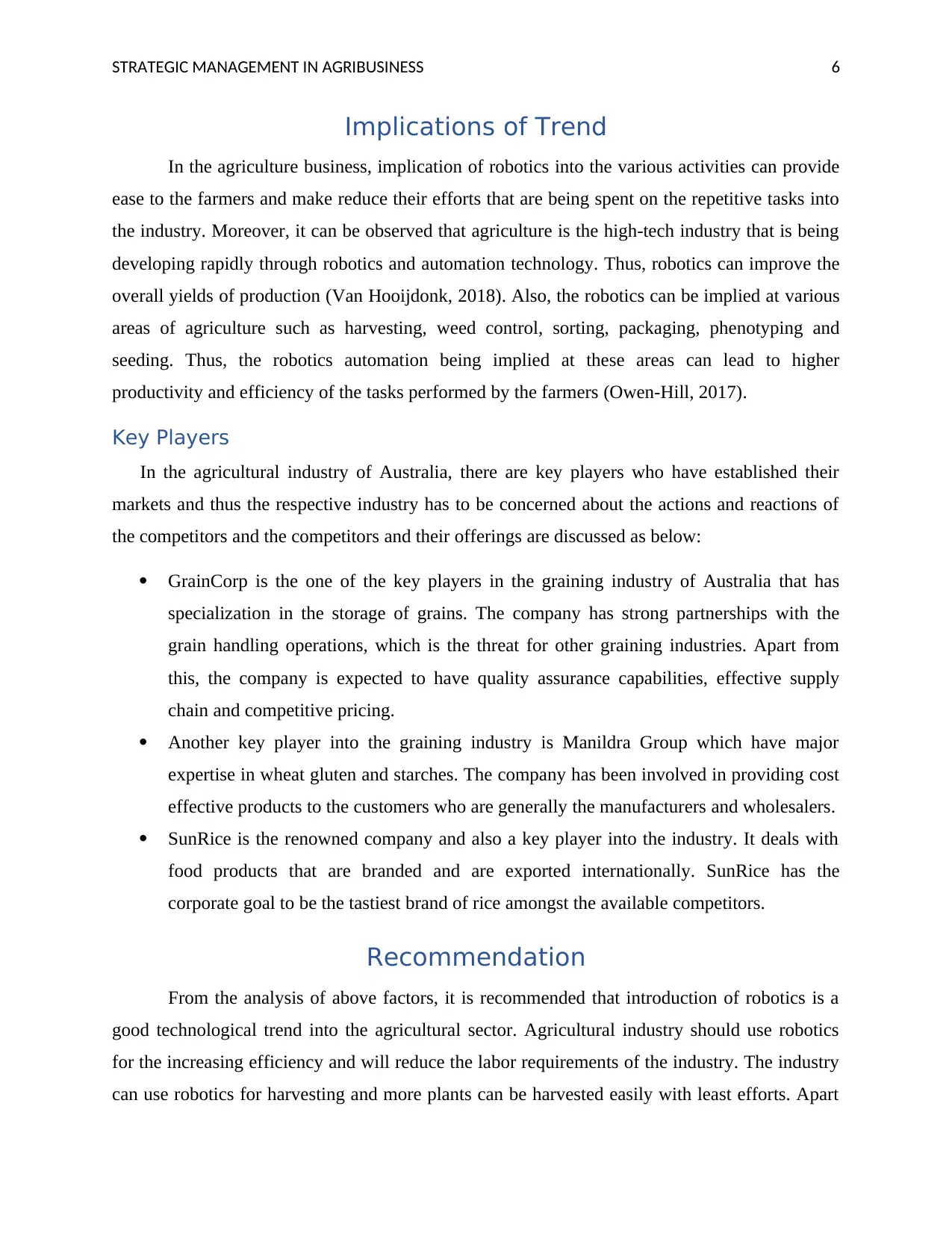
STRATEGIC MANAGEMENT IN AGRIBUSINESS 6
Implications of Trend
In the agriculture business, implication of robotics into the various activities can provide
ease to the farmers and make reduce their efforts that are being spent on the repetitive tasks into
the industry. Moreover, it can be observed that agriculture is the high-tech industry that is being
developing rapidly through robotics and automation technology. Thus, robotics can improve the
overall yields of production (Van Hooijdonk, 2018). Also, the robotics can be implied at various
areas of agriculture such as harvesting, weed control, sorting, packaging, phenotyping and
seeding. Thus, the robotics automation being implied at these areas can lead to higher
productivity and efficiency of the tasks performed by the farmers (Owen-Hill, 2017).
Key Players
In the agricultural industry of Australia, there are key players who have established their
markets and thus the respective industry has to be concerned about the actions and reactions of
the competitors and the competitors and their offerings are discussed as below:
GrainCorp is the one of the key players in the graining industry of Australia that has
specialization in the storage of grains. The company has strong partnerships with the
grain handling operations, which is the threat for other graining industries. Apart from
this, the company is expected to have quality assurance capabilities, effective supply
chain and competitive pricing.
Another key player into the graining industry is Manildra Group which have major
expertise in wheat gluten and starches. The company has been involved in providing cost
effective products to the customers who are generally the manufacturers and wholesalers.
SunRice is the renowned company and also a key player into the industry. It deals with
food products that are branded and are exported internationally. SunRice has the
corporate goal to be the tastiest brand of rice amongst the available competitors.
Recommendation
From the analysis of above factors, it is recommended that introduction of robotics is a
good technological trend into the agricultural sector. Agricultural industry should use robotics
for the increasing efficiency and will reduce the labor requirements of the industry. The industry
can use robotics for harvesting and more plants can be harvested easily with least efforts. Apart
Implications of Trend
In the agriculture business, implication of robotics into the various activities can provide
ease to the farmers and make reduce their efforts that are being spent on the repetitive tasks into
the industry. Moreover, it can be observed that agriculture is the high-tech industry that is being
developing rapidly through robotics and automation technology. Thus, robotics can improve the
overall yields of production (Van Hooijdonk, 2018). Also, the robotics can be implied at various
areas of agriculture such as harvesting, weed control, sorting, packaging, phenotyping and
seeding. Thus, the robotics automation being implied at these areas can lead to higher
productivity and efficiency of the tasks performed by the farmers (Owen-Hill, 2017).
Key Players
In the agricultural industry of Australia, there are key players who have established their
markets and thus the respective industry has to be concerned about the actions and reactions of
the competitors and the competitors and their offerings are discussed as below:
GrainCorp is the one of the key players in the graining industry of Australia that has
specialization in the storage of grains. The company has strong partnerships with the
grain handling operations, which is the threat for other graining industries. Apart from
this, the company is expected to have quality assurance capabilities, effective supply
chain and competitive pricing.
Another key player into the graining industry is Manildra Group which have major
expertise in wheat gluten and starches. The company has been involved in providing cost
effective products to the customers who are generally the manufacturers and wholesalers.
SunRice is the renowned company and also a key player into the industry. It deals with
food products that are branded and are exported internationally. SunRice has the
corporate goal to be the tastiest brand of rice amongst the available competitors.
Recommendation
From the analysis of above factors, it is recommended that introduction of robotics is a
good technological trend into the agricultural sector. Agricultural industry should use robotics
for the increasing efficiency and will reduce the labor requirements of the industry. The industry
can use robotics for harvesting and more plants can be harvested easily with least efforts. Apart
Paraphrase This Document
Need a fresh take? Get an instant paraphrase of this document with our AI Paraphraser
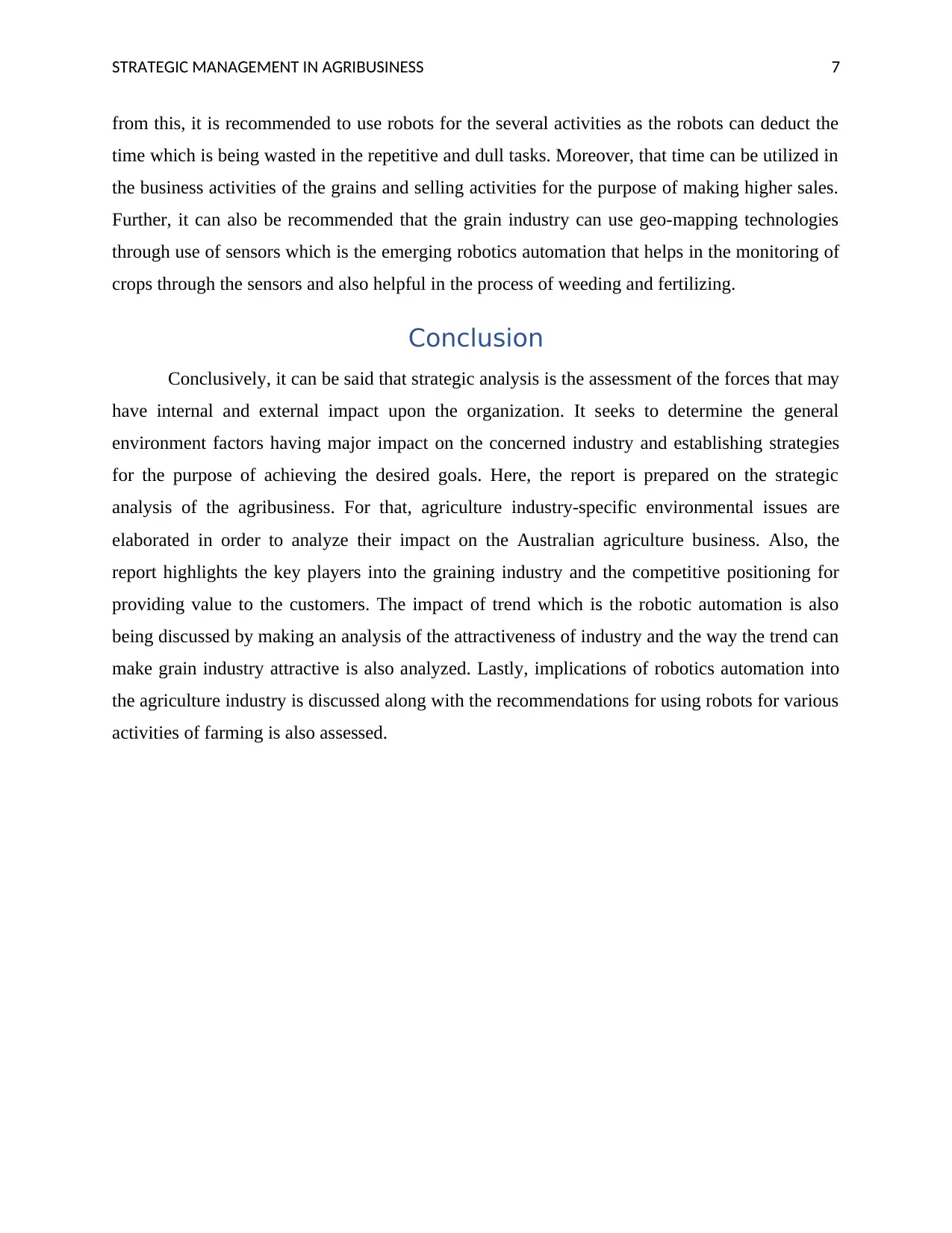
STRATEGIC MANAGEMENT IN AGRIBUSINESS 7
from this, it is recommended to use robots for the several activities as the robots can deduct the
time which is being wasted in the repetitive and dull tasks. Moreover, that time can be utilized in
the business activities of the grains and selling activities for the purpose of making higher sales.
Further, it can also be recommended that the grain industry can use geo-mapping technologies
through use of sensors which is the emerging robotics automation that helps in the monitoring of
crops through the sensors and also helpful in the process of weeding and fertilizing.
Conclusion
Conclusively, it can be said that strategic analysis is the assessment of the forces that may
have internal and external impact upon the organization. It seeks to determine the general
environment factors having major impact on the concerned industry and establishing strategies
for the purpose of achieving the desired goals. Here, the report is prepared on the strategic
analysis of the agribusiness. For that, agriculture industry-specific environmental issues are
elaborated in order to analyze their impact on the Australian agriculture business. Also, the
report highlights the key players into the graining industry and the competitive positioning for
providing value to the customers. The impact of trend which is the robotic automation is also
being discussed by making an analysis of the attractiveness of industry and the way the trend can
make grain industry attractive is also analyzed. Lastly, implications of robotics automation into
the agriculture industry is discussed along with the recommendations for using robots for various
activities of farming is also assessed.
from this, it is recommended to use robots for the several activities as the robots can deduct the
time which is being wasted in the repetitive and dull tasks. Moreover, that time can be utilized in
the business activities of the grains and selling activities for the purpose of making higher sales.
Further, it can also be recommended that the grain industry can use geo-mapping technologies
through use of sensors which is the emerging robotics automation that helps in the monitoring of
crops through the sensors and also helpful in the process of weeding and fertilizing.
Conclusion
Conclusively, it can be said that strategic analysis is the assessment of the forces that may
have internal and external impact upon the organization. It seeks to determine the general
environment factors having major impact on the concerned industry and establishing strategies
for the purpose of achieving the desired goals. Here, the report is prepared on the strategic
analysis of the agribusiness. For that, agriculture industry-specific environmental issues are
elaborated in order to analyze their impact on the Australian agriculture business. Also, the
report highlights the key players into the graining industry and the competitive positioning for
providing value to the customers. The impact of trend which is the robotic automation is also
being discussed by making an analysis of the attractiveness of industry and the way the trend can
make grain industry attractive is also analyzed. Lastly, implications of robotics automation into
the agriculture industry is discussed along with the recommendations for using robots for various
activities of farming is also assessed.
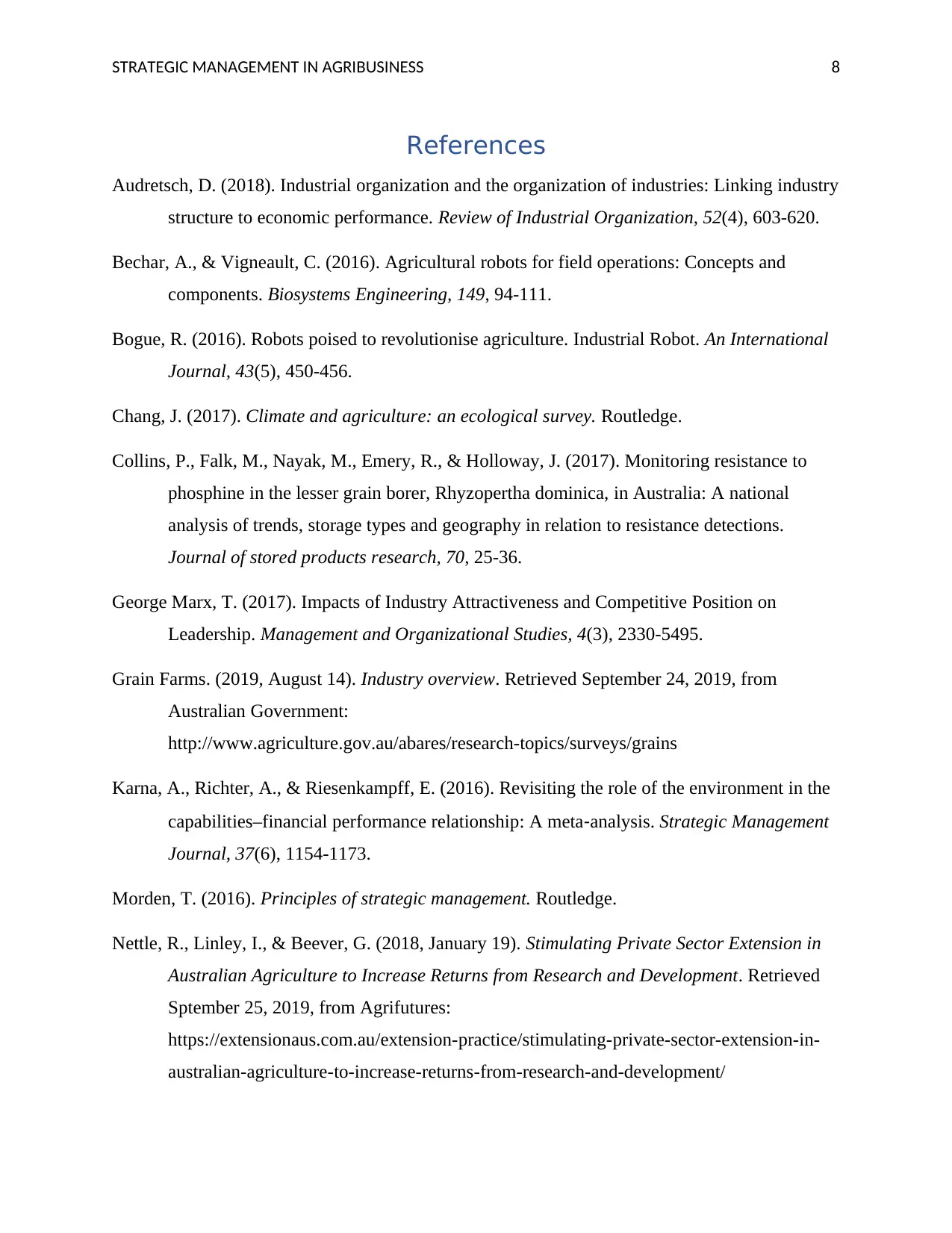
STRATEGIC MANAGEMENT IN AGRIBUSINESS 8
References
Audretsch, D. (2018). Industrial organization and the organization of industries: Linking industry
structure to economic performance. Review of Industrial Organization, 52(4), 603-620.
Bechar, A., & Vigneault, C. (2016). Agricultural robots for field operations: Concepts and
components. Biosystems Engineering, 149, 94-111.
Bogue, R. (2016). Robots poised to revolutionise agriculture. Industrial Robot. An International
Journal, 43(5), 450-456.
Chang, J. (2017). Climate and agriculture: an ecological survey. Routledge.
Collins, P., Falk, M., Nayak, M., Emery, R., & Holloway, J. (2017). Monitoring resistance to
phosphine in the lesser grain borer, Rhyzopertha dominica, in Australia: A national
analysis of trends, storage types and geography in relation to resistance detections.
Journal of stored products research, 70, 25-36.
George Marx, T. (2017). Impacts of Industry Attractiveness and Competitive Position on
Leadership. Management and Organizational Studies, 4(3), 2330-5495.
Grain Farms. (2019, August 14). Industry overview. Retrieved September 24, 2019, from
Australian Government:
http://www.agriculture.gov.au/abares/research-topics/surveys/grains
Karna, A., Richter, A., & Riesenkampff, E. (2016). Revisiting the role of the environment in the
capabilities–financial performance relationship: A meta‐analysis. Strategic Management
Journal, 37(6), 1154-1173.
Morden, T. (2016). Principles of strategic management. Routledge.
Nettle, R., Linley, I., & Beever, G. (2018, January 19). Stimulating Private Sector Extension in
Australian Agriculture to Increase Returns from Research and Development. Retrieved
Sptember 25, 2019, from Agrifutures:
https://extensionaus.com.au/extension-practice/stimulating-private-sector-extension-in-
australian-agriculture-to-increase-returns-from-research-and-development/
References
Audretsch, D. (2018). Industrial organization and the organization of industries: Linking industry
structure to economic performance. Review of Industrial Organization, 52(4), 603-620.
Bechar, A., & Vigneault, C. (2016). Agricultural robots for field operations: Concepts and
components. Biosystems Engineering, 149, 94-111.
Bogue, R. (2016). Robots poised to revolutionise agriculture. Industrial Robot. An International
Journal, 43(5), 450-456.
Chang, J. (2017). Climate and agriculture: an ecological survey. Routledge.
Collins, P., Falk, M., Nayak, M., Emery, R., & Holloway, J. (2017). Monitoring resistance to
phosphine in the lesser grain borer, Rhyzopertha dominica, in Australia: A national
analysis of trends, storage types and geography in relation to resistance detections.
Journal of stored products research, 70, 25-36.
George Marx, T. (2017). Impacts of Industry Attractiveness and Competitive Position on
Leadership. Management and Organizational Studies, 4(3), 2330-5495.
Grain Farms. (2019, August 14). Industry overview. Retrieved September 24, 2019, from
Australian Government:
http://www.agriculture.gov.au/abares/research-topics/surveys/grains
Karna, A., Richter, A., & Riesenkampff, E. (2016). Revisiting the role of the environment in the
capabilities–financial performance relationship: A meta‐analysis. Strategic Management
Journal, 37(6), 1154-1173.
Morden, T. (2016). Principles of strategic management. Routledge.
Nettle, R., Linley, I., & Beever, G. (2018, January 19). Stimulating Private Sector Extension in
Australian Agriculture to Increase Returns from Research and Development. Retrieved
Sptember 25, 2019, from Agrifutures:
https://extensionaus.com.au/extension-practice/stimulating-private-sector-extension-in-
australian-agriculture-to-increase-returns-from-research-and-development/
⊘ This is a preview!⊘
Do you want full access?
Subscribe today to unlock all pages.

Trusted by 1+ million students worldwide
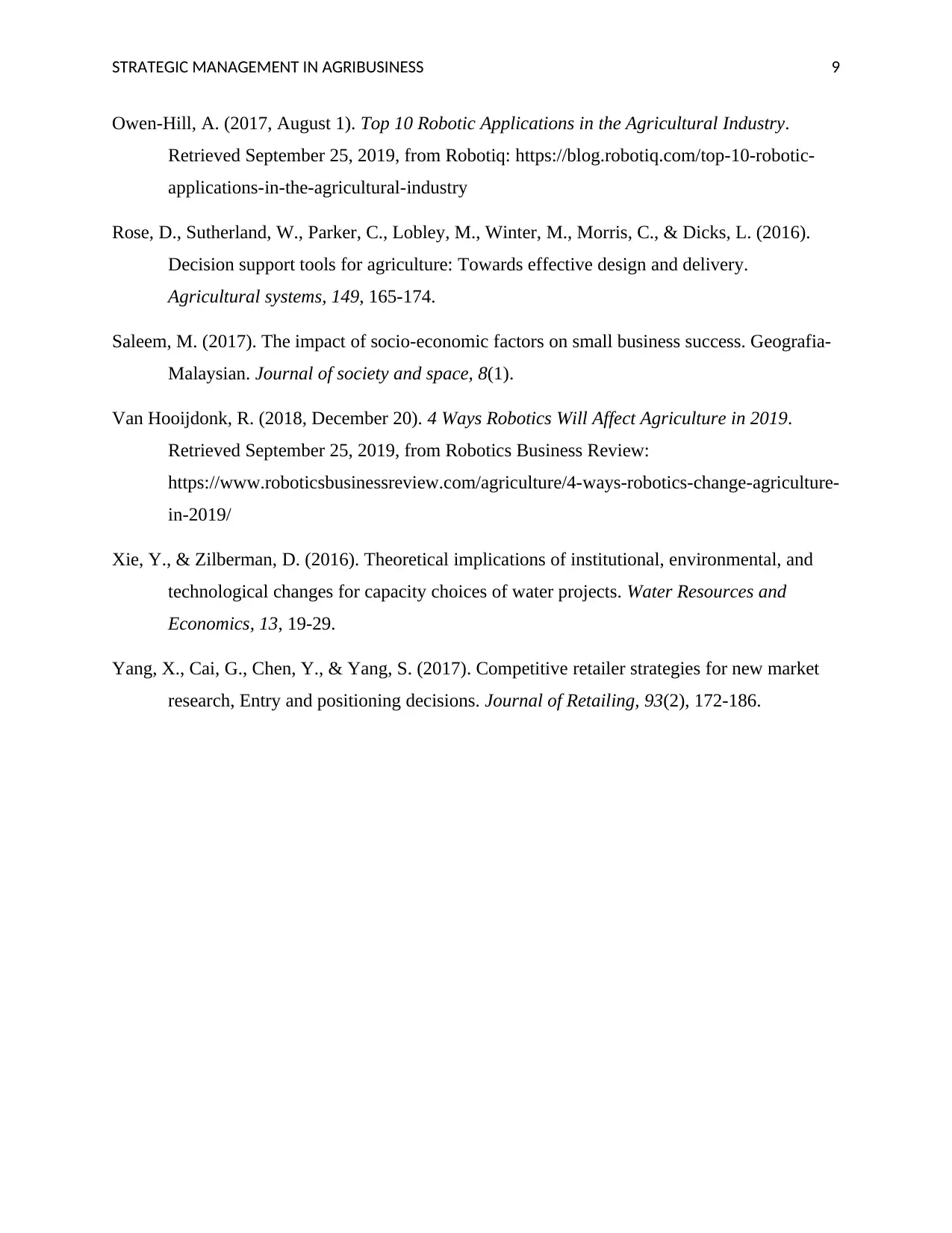
STRATEGIC MANAGEMENT IN AGRIBUSINESS 9
Owen-Hill, A. (2017, August 1). Top 10 Robotic Applications in the Agricultural Industry.
Retrieved September 25, 2019, from Robotiq: https://blog.robotiq.com/top-10-robotic-
applications-in-the-agricultural-industry
Rose, D., Sutherland, W., Parker, C., Lobley, M., Winter, M., Morris, C., & Dicks, L. (2016).
Decision support tools for agriculture: Towards effective design and delivery.
Agricultural systems, 149, 165-174.
Saleem, M. (2017). The impact of socio-economic factors on small business success. Geografia-
Malaysian. Journal of society and space, 8(1).
Van Hooijdonk, R. (2018, December 20). 4 Ways Robotics Will Affect Agriculture in 2019.
Retrieved September 25, 2019, from Robotics Business Review:
https://www.roboticsbusinessreview.com/agriculture/4-ways-robotics-change-agriculture-
in-2019/
Xie, Y., & Zilberman, D. (2016). Theoretical implications of institutional, environmental, and
technological changes for capacity choices of water projects. Water Resources and
Economics, 13, 19-29.
Yang, X., Cai, G., Chen, Y., & Yang, S. (2017). Competitive retailer strategies for new market
research, Entry and positioning decisions. Journal of Retailing, 93(2), 172-186.
Owen-Hill, A. (2017, August 1). Top 10 Robotic Applications in the Agricultural Industry.
Retrieved September 25, 2019, from Robotiq: https://blog.robotiq.com/top-10-robotic-
applications-in-the-agricultural-industry
Rose, D., Sutherland, W., Parker, C., Lobley, M., Winter, M., Morris, C., & Dicks, L. (2016).
Decision support tools for agriculture: Towards effective design and delivery.
Agricultural systems, 149, 165-174.
Saleem, M. (2017). The impact of socio-economic factors on small business success. Geografia-
Malaysian. Journal of society and space, 8(1).
Van Hooijdonk, R. (2018, December 20). 4 Ways Robotics Will Affect Agriculture in 2019.
Retrieved September 25, 2019, from Robotics Business Review:
https://www.roboticsbusinessreview.com/agriculture/4-ways-robotics-change-agriculture-
in-2019/
Xie, Y., & Zilberman, D. (2016). Theoretical implications of institutional, environmental, and
technological changes for capacity choices of water projects. Water Resources and
Economics, 13, 19-29.
Yang, X., Cai, G., Chen, Y., & Yang, S. (2017). Competitive retailer strategies for new market
research, Entry and positioning decisions. Journal of Retailing, 93(2), 172-186.
1 out of 10
Related Documents
Your All-in-One AI-Powered Toolkit for Academic Success.
+13062052269
info@desklib.com
Available 24*7 on WhatsApp / Email
![[object Object]](/_next/static/media/star-bottom.7253800d.svg)
Unlock your academic potential
Copyright © 2020–2025 A2Z Services. All Rights Reserved. Developed and managed by ZUCOL.





